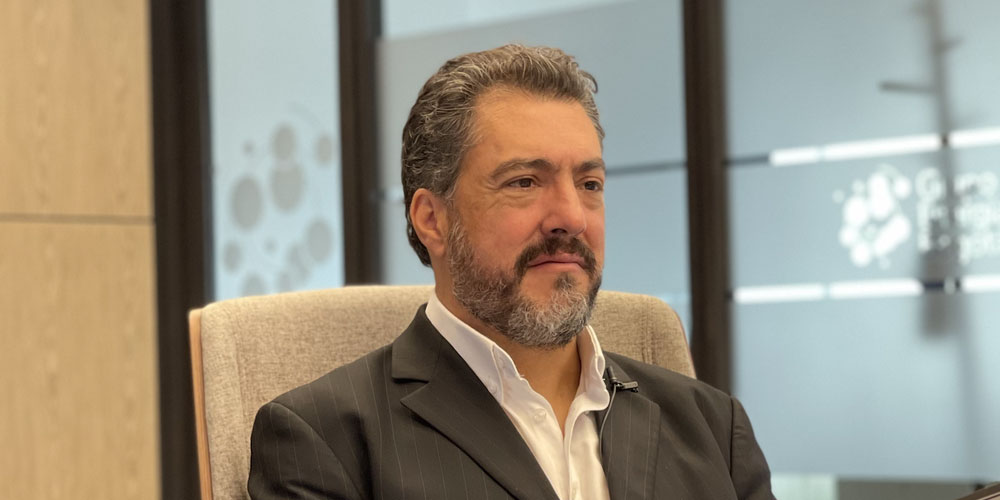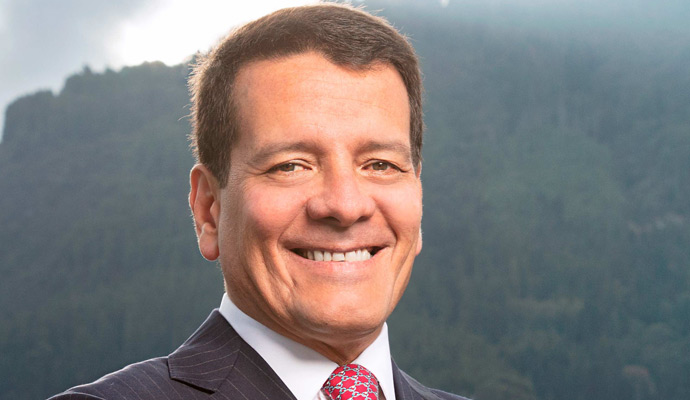A Colombian energy company’s bold bet on sustainability
The president of Grupo Energía Bogotá, Juan Ricardo Ortega, on the challenges of energy transition and environmental protection.
This interview is part of the Inside the Mind of the CEO series, which explores a wide range of critical decisions faced by chief executives around the world.
When Juan Ricardo Ortega was appointed president of Grupo Energía Bogotá (GEB), Colombia’s largest natural gas transporter and second-largest energy transmitter, in July 2020, he brought a unique set of skills and experiences to the role. Ortega was trained in economics, finance, and mathematics at the University of the Andes and then at Yale (where, at age 54, he’ll soon complete a Ph.D. in economic development). He began his career as chief economist at multinational banking company BBVA in Bogotá in the 1980s but later transitioned to the public sector, when he was appointed economic advisor to then Colombian President Andrés Pastrana.
Ortega went on to hold other high-level public positions, such as vice minister of finance and commerce and secretary of finance for the City of Bogotá, as well as professorships at Colombian universities. From 2014 to 2020, he worked as an advisor to the Inter-American Development Bank in Washington, DC, but returned to Colombia when he was appointed president of GEB. He joined at a critical moment, as the 125-year-old company expands its portfolio to include nonconventional renewable energy and increases its presence in Latin America. For example, in June 2021, GEB announced an agreement with the Italy-based energy multinational Enel to create Enel Colombia, a subsidiary that will include additional equity value of US$1.4 billion in renewable energy assets located in Colombia, Panama, Costa Rica, and Guatemala.
GEB is well positioned to make these moves. It stands out among other Colombian public utilities because of its shareholder structure—although the City of Bogotá owns the majority of its shares (65.7%), close to 35% are privately held—which helps it stay above the political fray. GEB’s net profits rose by 36% in 2020, and it will distribute $437 million in dividends this year. In a recent video interview with strategy+business, Ortega shared his thoughts on the future of the energy sector in Colombia, as the country moves beyond hydropower to embrace other renewables.
S+B: Looking ahead to the next few decades, how do you see your business transforming to meet energy needs in Colombia and, more broadly, in Latin America?
ORTEGA: The climate change and energy transition agenda is central for Colombia, a country where 70% of electricity already comes from renewables [the majority from hydropower]. Colombia’s government has set a goal of reducing net carbon emissions by 51% by 2030. That is a very aggressive goal.
At the same time, I think it would be unreasonable for a country like Colombia to commit to zero net emissions for the next ten to 20 years. Colombia contributes around 92.5 million tons of carbon a year. The world’s total figure is around 39 billion tons, which means Colombia’s carbon emissions are .25% of the global share. Therefore, if we commit to a zero net emissions strategy, it would hinder Colombia’s capacity to compete with other countries and to boost its economy, especially because the country has a lot of potential in gas.
I think there are very solid arguments to defend gas as a transition energy source in Colombia. It can support growth and employment and help Colombia become an increasingly competitive economy. If the heavy cargo industry, in particular, makes the transition [from oil] to gas, it would help to reduce particulate matter.
I also believe the most sensible decision is to switch commercial vehicles to run on electricity. That’s why our bet is on electric power. We believe it will be one of the big winners in the next 20 years. There is also a huge opportunity in the region as the transmission infrastructure from Mexico to Chile is integrated to enable a more efficient delivery of electric power from plants to customers. Colombia can greatly benefit from this process. We have the companies, the contractors, the value chains, and the expertise to help generate more resilient transmission networks throughout the region.
There are important growth opportunities in this matter, and that is why we are investing in Peru, Brazil, Guatemala, and Colombia—countries where we have a large transmission network, with thousands of kilometers of lines in operation. For example, in Peru we are leaders with ISA REP and ISA Transmantaro [energy transmission companies], and in Guatemala, we are working on an important energy transmission project. We want to position the company so that in the future we can make the most out of this integrated infrastructure and maximize growth.
S+B: What renewable sources will play a role in Colombia’s energy transition?
ORTEGA: Colombia has enormous wind and solar power potential in La Guajira. [Located at the northern tip of the country along the Caribbean Sea, the region gets abundant sunlight, and its average wind speed is more than double the world’s average.] Vichada, on the eastern plains, has great solar intensity, and southern Galerazamba, toward the north of the country, also has strong winds. There is also an opportunity for biomass energy. Colombia is already trying to make sugarcane into a source energy, and I think it can produce energy from methane emissions from landfills.
I have no doubt that hydrogen will be a viable source of power within the next ten to 15 years. We are trying to learn from Chile about hydrogen’s potential. Chile already has an excess of unconventional renewables in Atacama. They also have a mining industry that demands ammonia and heat, and, in that sense, hydrogen comes almost naturally to them.
In Colombia, hydrogen’s potential is not so obvious. To make it feasible, we first need energy available at a very low cost. For that, we need to grow our solar and wind farms in the next few years. We then need to do things like upgrade our gas pipelines to make sure they are less prone to corrosion. [Hydrogen, through a deterioration process called hydrogen embrittlement, can lead to corrosion and cracking in metals.] I don’t see this transformation happening yet. The cost of storing hydrogen and of transporting it has made that difficult. However, you already see countries like Germany with hydrogen stations and vehicles. And that is why I think this is a source of energy we need to pay close attention to. We need to study how to get there.
Finally, our recent agreement with Enel will allow us to have a share in the nonconventional renewable energy market. A new, international company is being formed from the merger of Emgesa, Codensa, and Enel Green Power. The new company will have a presence in Colombia, Panama, Costa Rica, and Guatemala, and will have an installed capacity of 5,470 megawatts by 2025, with a primary focus on renewable energy.
S+B: Besides investing in renewables, what is GEB doing to reduce its environmental impact?
ORTEGA: Sixty percent of Colombia’s emissions are the product of deforestation, which, in turn, comes from agriculture, livestock, and similar kinds of land use. Rather than focus on a zero net emissions strategy, a more efficient way to reduce our environmental impact would be to tackle deforestation and unsustainable cattle ranching. I think that is where the real problem is.
With this in mind, our company’s strategy is based on restoring native forests. Now, this isn’t about planting trees. What biologists have recommended is for us to focus on the recovery of ecosystems. We are using our electric and gas infrastructure to create corridors that interconnect natural parks and ecosystems. This way we can expand spaces that help to preserve biodiversity and native species. We have successful examples of this, specifically in southern Colombia with the preservation of two species of native fauna—the mountain tapir and the spectacled bear.
In another example from southern Colombia, in Putumayo, our local branch has done an amazing job restoring all of the infrastructure that was destroyed in the landslides that hit Mocoa, Putumayo’s capital, in 2017. We have learned to build with very little impact on nature. We now make towers that are very lean and tall. They stand in small areas and therefore don’t require us to cut down a large number of surrounding trees. We no longer use bulldozers to install cables. Instead we use drones and very small paths.
S+B: What do you believe are the greatest challenges in pursuing a sustainability strategy?
ORTEGA: Many Colombians don’t yet fully understand the magnitude of environmental threats. We keep thinking that climate change is a subject for others to discuss. But we are already seeing climate change phenomena in Colombia, like El Niño, La Niña, and prolonged droughts. Weather projections say that for up to 30% of the year, La Guajira could have temperatures of 50 to 60 degrees Celsius. That would make this region uninhabitable.
The greatest challenge we have is communication. False stories have spread on social media that we need to fight against, for example, that cows produce green milk as a consequence of being near our towers, or that the towers have caused leukemia in children. It makes people believe that electrical infrastructure is a threat to the environment and communities, when in fact, it helps them. For example, cooking with charcoal and firewood has led to terrible lung diseases.
The empirical facts, unfortunately, are not being communicated. And it is so hard for us to refute these ideas, to convince people that this infrastructure is not a threat. We face a very great challenge in Colombia in earning credibility and the trust of the people. But it is our duty to try to earn that trust. And that is, in part, why we have a strategy to regenerate ecosystems. We believe it can help us build relationships with communities. Through positive results, we can show them that preserving nature is compatible with our infrastructure.
S+B: What do you believe government can do to help?
ORTEGA: The government needs to help address the misinformation problem. It should focus on education, to make sure everyone has a basic level of knowledge about climate change threats.
It is our duty to try to earn [people’s] trust. Through positive results, we can show them that preserving nature is compatible with our infrastructure.”
There is also the need for better legislation to enable the energy transition. Carbon taxes are, in my opinion, essential. And we must discuss, as a society, the costs of externalities. The global average tax for a ton of carbon is around [US]$60 to $70. In Colombia, it is just $5. That sends a weak message. We can’t change this overnight, but we do need to take steps so that people start migrating from diesel, gasoline, and coal.
This can be done gradually. For example, I believe the owners of all those luxurious four-wheel-drive cars could pay a carbon tax that compensates for the impact of their vehicles. When they begin to see what it costs to own these cars, they will start to migrate to electric vehicles. And in Colombia, we also need to have a conversation about the kind of hybrid vehicles we have. So much of what is called a hybrid in Colombia isn’t really hybrid. They are cars that have miniature batteries—people buy them to get around circulation restrictions, such as pico y placa, which restricts traffic during rush hours in several Colombian cities.
Moreover, countries that are implementing these measures—taking adequate steps, imposing taxes, and assuming all the costs of protecting the environment—should be able to defend themselves against countries that are not, and are thus unfair competitors. For example, the United States is already thinking about this, by making certain demands on foreign companies that want to access its market.
The government and the energy sector also have to think about what is going to happen with certain industries that will disappear, like the coal industry. They employ a lot of people. So how are we going to employ all of those who could be jobless in the future? And how are we going to deal with the infrastructure that will become obsolete? These are very uncomfortable and difficult debates, but they are imminent.
S+B: For Colombia, specifically, what government investments do you think would have the greatest impact?
ORTEGA: We believe La Guajira deserves a national discussion. We need to understand how the local economy of the Wayuu ethnic community, which lives in La Guajira and is very poor and vulnerable, can become viable.
One thing we can do is to create good-paying jobs for 20, 30, or even 40 years. And we can generate research and development in a region that has an immense potential if only the right infrastructure is built there. For that, however, we need to recognize that for centuries this region has suffered from complex crime problems and a lack of state presence.
I believe companies like ours can help by pushing for an important part of our taxes to be combined with social responsibility programs. That way we can help transform La Guajira. But we can’t do that alone. We need a state that can provide the services and benefits that only governments can provide. In particular, the state needs to strengthen its justice system and its capacity to conduct criminal investigations.
S+B: What is the role of digital transformation in GEB’s evolution?
ORTEGA: Our investment in a digital agenda has helped us, particularly with our managerial efforts—our ability to understand what we need and to trace what’s happening. For example, we discovered during the pandemic that we had huge investments in equipment and technologies that were underutilized. We’ve also started to embrace automation.
Of course, some people feel threatened by automation. They worry that they will become irrelevant or that they will lose their job. But automation actually facilitates growth. It allows us to relocate people to roles where they are really needed or where they could be more productive. And computers don’t automatically solve management problems. Ideally, automated systems make life easier for people and allow for accountability. But all that requires great support from a solid and mature organization. Otherwise, these systems won’t flourish.
S+B: How is digitization enabling your company’s sustainability goals?
ORTEGA: Colombia is currently debating introducing AMI [advanced metering infrastructure], or smart meters, for energy consumption. This technology is not yet widely available in developing countries like Colombia because it is too expensive. But as the price drops, smart meters will become available and will allow us to charge for energy at an average cost relative to a time frame. For example, if you want to bake a cake late at night when fewer people are consuming energy, you are going to pay less than if you baked it at dinnertime. Our capacity to transition into electric cars also depends on the ease of charging vehicles [at hours] when energy is cheaper. With this system, people could use energy 24 hours a day and in a much more efficient way.
This kind of innovation can also help people understand which appliances end up being more expensive because they use more energy. For example, people would realize how much it costs to have an old refrigerator. And, going further, we could even offer incentives, like credit, so that people can replace those inefficient refrigerators. In the end, that investment will pay for itself because people will save money on energy.
Obviously, we need to handle this kind of data with care, and we need to have rules that protect users’ identities. Once we do that, offering these new kinds of products will make people’s lives much easier and generate enormous value for them.
S+B: In terms of protecting data, what measures are you taking against cyber threats?
ORTEGA: Last year, we had a cyberattack, even though we had bought all the protection software needed to mitigate the risk of our employees working from home. It happened while we were trying to implement our new defense system, and our staff was not fully trained yet. They identified the attack a bit late. Fortunately, we managed to defend ourselves by shutting down the servers before the attackers accessed sensitive databases. In the end, we had an operational problem of only a few hours. But this was a wake-up call for us, as we realized it was an attempt to extort us.
After that attack, we have focused on training our staff against cyber threats. We realized that we will not be protected until every employee is trained, until everyone is a part of our company’s security. Digital innovation has also made the electricity sector more vulnerable, as we saw in Ukraine in 2015, when Russian hackers left millions without power for more than 24 hours. You have to be on top of cybersecurity every day, and be aware that you should go the extra mile to protect your company.
Author profiles:
- Carlos Mario Lafaurie is the territory senior partner for PwC Colombia, based in Bogotá.
- Mariana Palau is a freelance journalist based in Bogotá.





